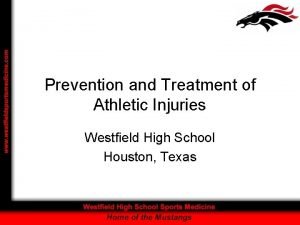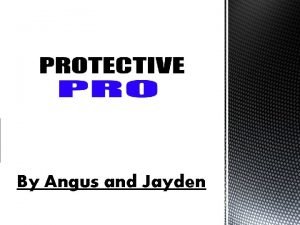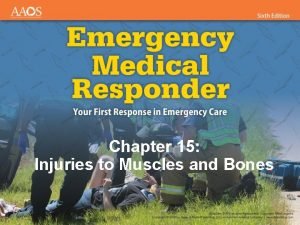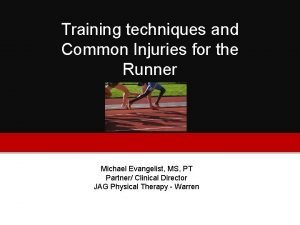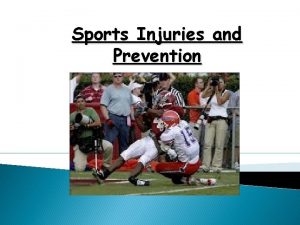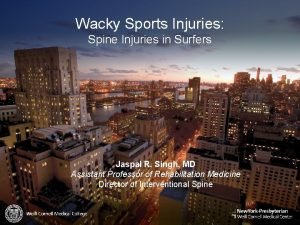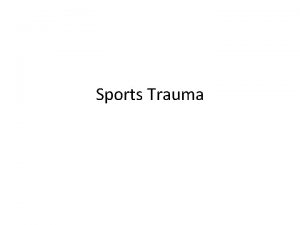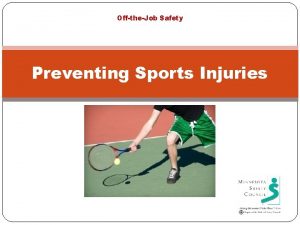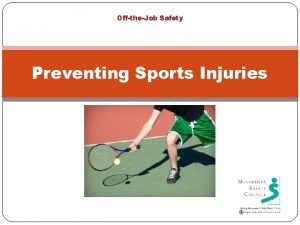Classifying and managing sports injuries Injuries are a



















- Slides: 19

Classifying and managing sports injuries

Injuries are a part of sport. They occur more frequently in contact sports such as football, but may be the result of overuse caused by movements such as running. Sport injuries are usually classified according to their cause. The most common classification is to identify injuries as direct, indirect or overuse injuries. They can also be soft tissue or hard tissue injuries.

DIRECT INJURIES Some injuries are caused by direct forces generated from outside the body. Direct injuries result in fractures, dislocations, sprains and bruises. A shoulder dislocation caused by a tackle in football or a broken jaw caused by getting hit with a cricket ball are examples of direct injuries.

INDIRECT INJURIES In contrast to direct injuries, indirect injuries are caused by a force from within the body. They are the result of excessive force being placed on the muscles, tendons and ligaments, causing pain and possible damage to body structures. An example of indirect injuries is a sprinter tearing a hamstring.

OVERUSE INJURIES Overuse injuries result from intense or unreasonable use of joints or body areas. They are caused by repetitive, low impact exercise such as jogging or stepping. These injuries cause pain and inflammation around the site of the injury. Typical overuse injuries include shin splints and tendonitis.

SOFT TISSUE INJURIES Soft tissue injuries include damage to the muscle, tendons, ligaments, cartilage, skin, blood vessels, organs and nerves. These may be acute – occurring suddenly such as a sprain, or chronic – occurring over a prolonged period of time. The following are examples of soft tissue injuries.

Tears and Contusions A tear occurs when tissue is excessively stretched or severed. Two types of tear are sprains (the stretching or tearing of a ligament) and strains (the stretching or tearing of a muscle or tendon). Both sprains and strains can be classified according to the severity of damage. First degree = little damage Second degree = moderate damage Third degree = extensive damage.



INFLAMMATORY RESPONSE When soft tissue is injured, it becomes inflamed but responds by activating a self healing process. This is known as the inflammatory response and may last for up to 3 -4 days after the injury occurred. There are 3 phases of the inflammatory response;

Phase 1 – inflammatory stage This is characterised by; ü Pain, redness and swelling ü Loss of function and mobility ü Damage to the cells and surrounding tissue ü Increased blood flow to the area ü The formation of blood vessels to promote healing

Phase 2 – repair and regeneration This is characterised by; ü The elimination of debris ü The formation of new fibres ü Production of scar tissue

Phase 3 – remodelling stage This is characterised by; ü Increased production of scar tissue ü Replacement of the tissue that has been damaged ü Reduced swelling ü Increased flexibility ü Regaining full function This will only happen if correct treatment is applied

Skin abrasions, lacerations and blisters Abrasions, lacerations, and blisters are forms of skin trauma. They are caused by the application of force, such as scraping or friction to the outer layer of the skin.

Abrasions occur in games such as netball, where a player may fall on a hard and dry surface. The injury causes pain and shallow bleeding as a result of the skin being scaped. The skinned area may be embedded with dirt and foreign materials. Treatment usually involves gentle cleansing and sterilisation of the wound to prevent infection.

Lacerations A laceration is a wound where the flesh has incurred a tear. Lacerations can occur to most parts of the body but are particularly common on the scalp and face. In the event of a laceration the area needs to be thoroughly cleaned and pressure may need to be applied to stop any bleeding. Lacerations longer than 1 cm in length need to be treated by a doctor.

Blisters are caused by a collection of fluid below or within the upper layers of the skin causing intense pain. Blisters can contain clear liquid or even blood if a blood vessel has been ruptured. Blisters occur when; ü New equipment is being worn or used ü Equipment is used for a long time ü The activity requires sudden changes of direction, causing friction

Recap…. . • Injuries can be classified into 5 different categories. What are they? • What is a direct injury? • What is an indirect injury? • What is an overuse injury caused by? • List the tissues in the body that are classified as soft tissue? • List the tissues in the body that are classified as hard tissue?

Recap cont…. . • What are the 3 phase of the inflammatory response? • What is an abrasion? • How might lacerations occur? • What is likely to cause blisters? • How are blisters treated? • What causes calluses?
 Antigentest åre
Antigentest åre Chapter 11 assessment and evaluation of sports injuries
Chapter 11 assessment and evaluation of sports injuries How are sports injuries classified and managed
How are sports injuries classified and managed Westfield sports injuries
Westfield sports injuries Chapter 13 worksheet recognizing different sports injuries
Chapter 13 worksheet recognizing different sports injuries Sports injuries angus, on
Sports injuries angus, on Indoor outdoor sports
Indoor outdoor sports Unit 15:9 providing first aid for bone and joint injuries
Unit 15:9 providing first aid for bone and joint injuries Chapter 28 head and spine injuries
Chapter 28 head and spine injuries Chapter 21 caring for head and spine injuries
Chapter 21 caring for head and spine injuries Injuries to muscles and bones chapter 15
Injuries to muscles and bones chapter 15 Chapter 14:1 using body mechanics
Chapter 14:1 using body mechanics Chapter 14 bleeding shock and soft tissue injuries
Chapter 14 bleeding shock and soft tissue injuries Chapter 13:2 preventing accidents and injuries
Chapter 13:2 preventing accidents and injuries Chapter 12 lesson 4 fitness safety and avoiding injuries
Chapter 12 lesson 4 fitness safety and avoiding injuries Common track injuries
Common track injuries Characteristic of a triangle
Characteristic of a triangle Kingdom phylum class order
Kingdom phylum class order A-b rational or irrational
A-b rational or irrational Classifying polynomial by degree
Classifying polynomial by degree



